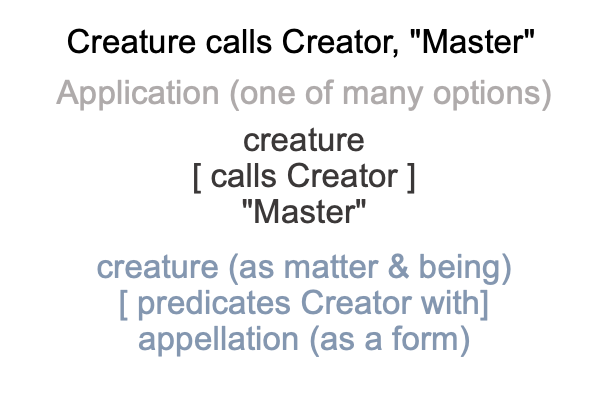0052 Now, I wonder whether my evolutionary associations and speculations are relevant to Duma’s five samples of Aquinas’s use of dici relatives. These five cases appear in section two.
0053 The first case occurs in Summa Theologica (I, q.13, a.7, ad 1). Predicated relatives are like master and servant. Transendental relatives are like body and soul. So the following, would be a predicated relative.
Here is a dyad. The two real elements are the creature and what the creature says. The contiguity is the “cause” that brings the two real elements together in Peirce’s secondness.

0054 In the second sample, from Peter Lombard’s Sentences (d.30, q.2 a.1.c., ad.4), Aquinas mentions the above example, adding that a term such as “knowledge” signifies something that is founded within this relation, and may be labeled as a secundum dici relation.
My guess is that the creature knows that “master” is an appropriate label to apply to one’s creator.
So, the creature knows what to say and how to say it.
0055 In hand talk, the appellation would be a gesture of self-humiliation, such as laying flat on the ground or kneeling. Tradition establishes the protocol. The one who kneels associates to matter and dici (hand talk). The one who is being knelt to associates to form and relationes. The kneeling one (like matter and dici) honors (the contiguity or “cause”) the one who is being knelt to (like form and relationes).
In hand talk, dici (hand talk) [predicates] relationes (the relation).
Hand talk does so because it coheres with esse (existence) [secundum] relationes (relation).
0056 Speech-alone talk produces an odd reversal. The creature who would be gesturing, but is now speaking, associates to matter and relationes. The specific terminology of the appellation associates to form and dici (speech-alone talk). The contiguity involves knowledge.

Does this imply that relationes (the relation) [predicates] dici (speech-alone talk)?
0057 In the third sample, Aquinas considers Disputed Questions on the Power of God.
What is the character of the distinction between relationes secundum esse and relationes secundum dici?
Well that should be obvious.
0058 If I ask, “How do I get to the farmer’s market.”
The answer, “Go to the town square.”, expresses the esse relation.
The answer, “Go down the street until St. Mary’s Church, then turn right and go two blocks.”, expresses the dici relation.
0059 Esse relations have one terminus in the real (in this answer, the town square).
Dici relations have one terminus in reason (in this answer, a right turn at a landmark).
0060 So, I wonder, what is Aquinas up to?
Why does philosophy arise in ancient Greece? Why is Aristotle so revered? Here is one answer.
Opinions (beings of reason or ens rationis) cannot be trusted. What is real (beings of realness or ens reale) are far more trustworthy. So, the task of the philosopher is to ascertain what is real in the face of a variety of opinions.
0061 Ah, that sounds like Aquinas’s agenda.
Relationes secundum esse have one terminus in the real.
Relationes secundum dici (speech-alone talk) have one terminus in… well… whatever anyone wants to say is real.
